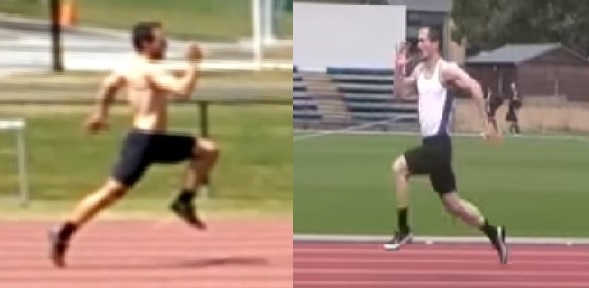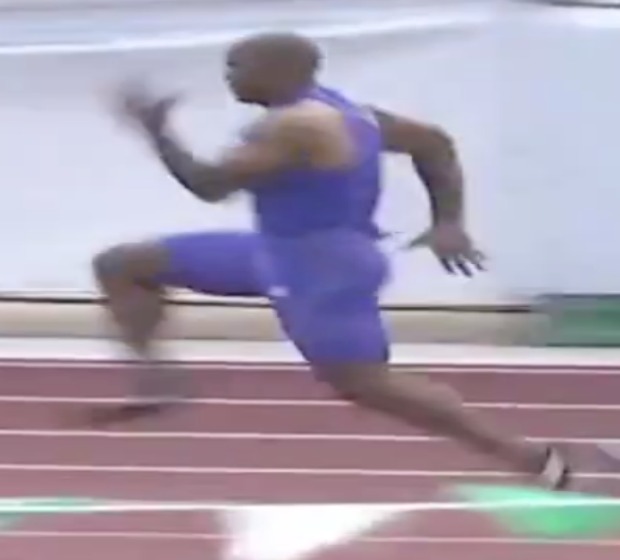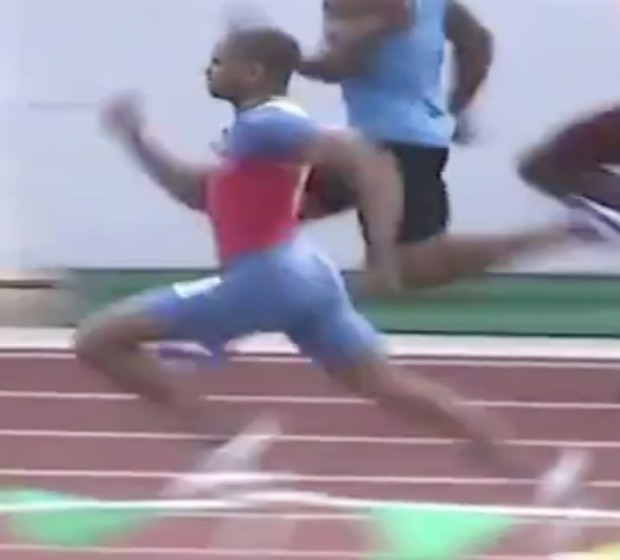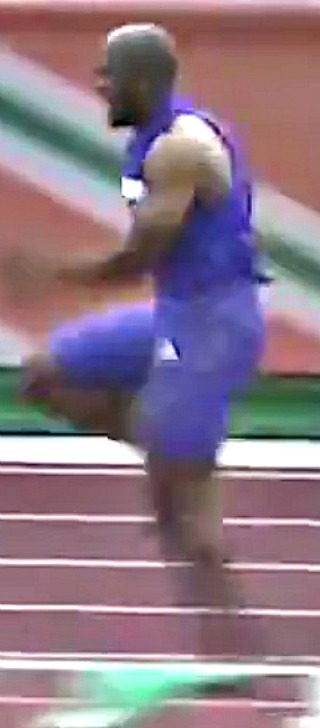race from today. He looks good
Good to see him approaching form.
He has virtually eliminated all backside mechanics.
same thing i was thinking. nasty how he pulled away. My boy that was at the meet said he yelled so loud once he hit max v that the whole stadium heard it. lol
Robin1, that’s actually not the case. If you look at Dix in slow motion what you see is that he maintains fantastic pelvic position (quite neutral). This then gives the appearance in real time that very little is happening backside (we the same from Powell) when, in fact, they achieve full extension like everyone else. It’s just that most other sprinters are exhibiting greater pelvic rotation which exaggerates backside action by way of the angle at which the extension occurs.
Here are stills from Dix and the sprinter in Lane 3 at max V. Note the position of the pelvis and the differential in magnitude of forward rotation between Dix and the sprinter in lane 3.
The comparison of the two of them reveals the illusion in both backside as well as front side leg mechanics. If you notice the sprinter in lane 3, his knee lift is as significant as Dix’s in terms of hip flexion. The difference is that Dix’s pelvis is neutral thus we are seeing ~90 degrees of hip flexion which aligns parallel with the X axis of the ground. This, particularly in real time, gives the illusion of “high knees”.
Meanwhile, sprinter in lane 3 is also flexed to ~90 at the hip, however, his forward pelvic rotation presents the illusion that his hip is not flexed as much as Dix due to the acute angle between his pelvis and the X axis.
Take note coaches who are cueing knee lift without taking notice of the position of the pelvis; as optimizing pelvic neutrality will enhance “knee lift”, and mitigate kicking out the back, by default.
Thanks James for the nice analysis. What I meant is that his hip hardly extends (his thigh is in line with his trunk at his maximal point of hip extension) and his knees do not fully extend at the back either. You can see these two things in the picture you shared. I agree that much of this has to do with pelvic positioning. Asafa, Michael Frater, James Dasaolu (when he was in good shape, ie. his 9.91) are doing something very similar, and its working well, so I wasn’t criticising but rather sharing an observation. In fact, after seeing this I decided to try and go back to running more like this again after having tried to increase my hip extension in the past in an effort to lengthen my stride. The result seems to have been longer foot contacts with little or no gains in stride length.

This is me at full hip extension 9 years ago (right) vs. 1.5 years ago (left). Plan is to go back to running more like I did back then.
Robin1, correct in that extension for those in a position of neutral pelvic alignment occurs closer to the Y axis. This is, in fact, because of the position of the pelvis and what we “should” see from all sprinters in the upright position.
Here’s another one of Dix where we see the most extension occurring “underneath” him as opposed to behind him.
Similarly, in early acceleration out of the blocks the angle of extension, while acute with respect to the X axis, should be similar as in the upright position as the relationship between the pelvis and torso should be consistent throughout.
Regarding your photos, well stated as it is clear that the more recent photo illustrates a longer ground contact patch.
So is having neutral pelvis in upright (max velocity) mechanics like Dix and Powell different from “sitting back?” what I mean by sitting back is some people often pop up too high, their knees are going up, but hips are dropping as a consequence, and full extension is lost, resulting in loss of ground contact forces. These people with sitting back mechanics often tend to reach forward too much with their front side mechanics and paw the ground, which causes longer ground contact times.
I wonder what’s different between neutral pelvis style vs sitting back…is sitting back caused by attempting to run with neutral pelvis with insufficient technique and flexibility/mobility? or is it caused by exaggerated attempt to run with neutral pelvis? or are those two not really related in that regard?
His first 200 of the year
This is the best vid I can find from his 200 on saturday
Kwave, the point of distinction to be made here, is the issue with non-scientific slang. Every coaching discipline has it and the problem is that the slang doesn’t always align with, for example, biomechanical truth. Further, problems escalate when the slang that is created is too ambiguous and therefore leaves too much liability for performance error, such as the very circumstance you’ve described.
We notice that “neutral pelvic alignment or 0 degrees of rotation” is absolutely unambiguous/no two ways about it, clearly understood across languages, whereas, sitting back, stepping down, turn over, and so on would raise an eyebrow if someone wasn’t already familiar with the T&F vernacular.
In my view, the problem with “sit back” will just as easily encourage someone to drop their hips (negative vertical displacement) as it will to encourage them to reduce the amount of forward rotation.
Much more efficient is to: 1. demonstrate slow motion footage of sprinters like Dix and Powell who do it well and have discussion about what’s happening, 2. utilize drills, such as the running A, as teaching tools to get the posture right because the drills allow ample time for cues and feedback while the exercise is happening. 3. provide instant video feedback to the sprinter/athlete with your phone or video camera
Something like the Running A is then flexible to be extended into a tempo variety from extensive, to intensive, and modulate right into high intensity sprinting with the corrected pelvic position. Further options to reinforce the posture are exercises such as wicket drills.
What would be the distinguishing characteristics between a “neutral pelvis” and “sitting back”? Or is sitting back just bad terminology which leads to - vertical displacement etc. I guess I’m confused when you say “Much more efficient is to: 1. demonstrate slow motion footage of sprinters like Dix and Powell who do it well and have discussion about what’s happening…” Are Powell and Dix better than others at “sitting back”? Perhaps a better question would be how do you cue posture? Personally I feel as though I’m leaning back when I try to get into design posture and then the train wreck ensues - "their knees are going up, but hips are dropping as a consequence, and full extension is lost, resulting in loss of ground contact forces. These people with sitting back mechanics often tend to reach forward too much with their front side mechanics and paw the ground, which causes longer ground contact times."
BEGR8, the problem is that neutral pelvic alignment is definitive and sitting back is much too open to interpretation. Maybe sit back resonates with one sprinter, they do what they interpret as sitting back and their anterior pelvic rotation neutralizes; whereas another sprinter sits back and all that happens is their hips drop and rotation stays as is.
Think about it practically and perform the following field experiment: stand in front of a chair and intentionally sit back as you sit down. Take note of the angle of your torso. You’ll find that the farther you attempt to sit back, the more acute the angle your torso will make with the floor. Then ask yourself just how good of a cue it is to “sit back”
Now, for the second experiment, stand in profile in front of a mirror with your shirt off. 1. intentionally arch your lower back and stick your chest out (this is anterior tilt/forward rotation). 2. Now do the opposite by bracing your abdominal wall, contracting your glutes, and rotating your pelvis posteriorly to the neutral position. You’ll know that you are neutralizing the pelvic position as you see the arch you created in step 1 become smaller and smaller.
Powell and Dix and not better at “sitting back”, they are better at sprinting with minimal forward pelvic rotation.
Thus, the key, in my view, is to remove all possibility for confusion by speaking definitively.
@5:36 if you dont have breaking mechanics you dont need much back side…aka dix in that video.
Thanks for the explanation, I totally get the issue with track slang. I was equating sitting back with leaning back which would create more of a slightly obtuse torso angle; which proves your point.
Is this Dix? I think the angle of the video is skewing what we are seeing. That’s a fantastic still shot that clearly shows he has ideal hip extension.
What point of the race has this still been taken?
Yes that is Dix Angela, I took the still at around the 70-80m mark.


